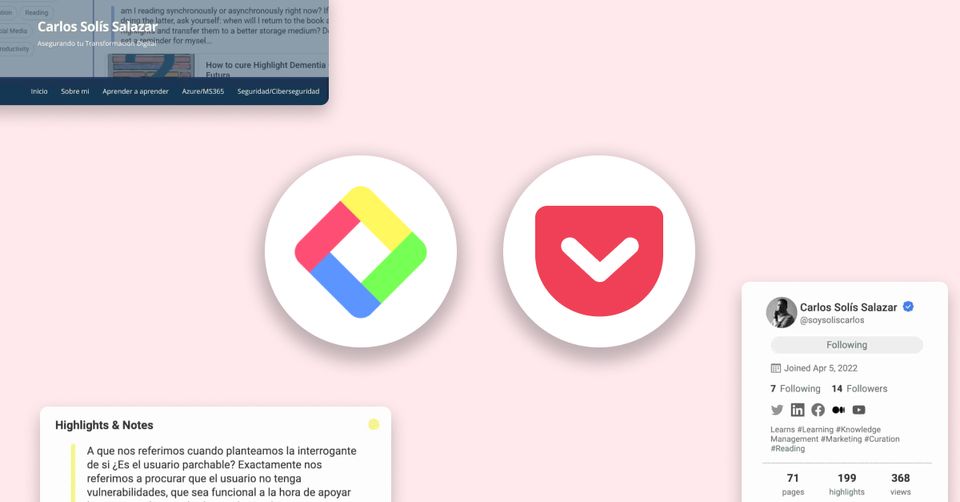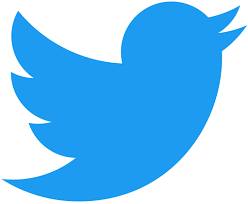Glasp and Pocket with Carlos Solís Salazar

Thankfully, we get a lot of feedback from our learners. Many of the feedback is insightful and helpful for us to improve and build Glasp. Today, we talked to Carlos, a learner in Panama. He wrote an article about Glasp on his website and translated our Ness Lab’s articles into Spanish. Let’s take a look at his use case and workflow together. He will give us a lot of insights to improve our learning system.
What you will learn in this article
- Use Case of Glasp
- Value of Glasp
- Before Glasp - Problems
- Advice on Information Organization
- Appendix
Background
Carlos lives in Panama and works as an information security engineer. He’s learning about learning, knowledge management, and reading. He uses Pocket to save articles that interest him. He recently started using Notion for his permanent note-taking place. He is a community ambassador of some learning communities and teaching university students.
• Glasp (highlight + content discovery)
• Pocket (read-it-later)
• Notion (permanent note-taking place)

Use Case of Glasp
Glasp: Thank you for having a chance to talk to us! First of all, could you tell us when and how you use Glasp?
Carlos: Sure. I use Glasp to highlight the part I like in the article, leave notes, find important parts of the article later, and search content I read before. I usually read articles after work, so I typically use Glasp in the evening.
Thanks. Could you tell us your general content discovery flow? Do you find the content you want to read from newsletters, Twitter, Linkedin, Google, or any resources?
When I wake up in the morning, I open the email and then see newsletters. If the title interests me, I save it on Pocket. And I see Twitter and Linkedin, if I find interesting content, I save it on Pocket, too. Before or during work, I use Feedly. The flow is the same as others, if I find an interesting title, I keep it on Pocket. I also find content on the Home feed of Glasp, too.
You save everything on Pocket. That’s actually the same flow as me. What would you do after that?
Oh, are you? Yeah, I open Pocket with the desktop and I open articles that I saved. Usually, there are a lot of content on Pocket, I open some of them that I want to read now. While I’m reading an article and when I find an important sentence or a part I resonate with, I highlight it with Glasp. And after I finished reading, I add a tag to the article on Pocket, then I archive it. And I tag articles on Glasp, too.
That’s interesting. Why would you add a tag after reading?
It’s because I don’t know the content until I read. It’s sometimes hard to choose which tags to add with only the title of the article.
That makes sense. What kind of content do you usually read and highlight with Glasp?
It’s both personal development and about my job. I usually read job-related content that I find in newsletters or Feedly. And Glasp sends me a newsletter and has a #read5for5 reading campaign, so I keep this content and read them. The quality of the content is great, so I like it.
Value of Glasp
What would make you use Glasp? Why Pocket is not enough?
It’s because I cannot search for content I read before easily. Even though I add a tag to the article, it’s not easy to search it with a phrase or find it with only tags. And even if I highlight sentences with Pocket, it’s not reflected in the search result and the number of highlights is limited to up to three for free users.
Also, I save a lot of content on Pocket, so it’s going to be messy. Even if I add tags and try to organize, there is more content I save than I consume, so there are a lot of articles I thought I should read but I actually haven’t. And without a good search function, I think it becomes harder to stay organized and find content.
I see. It’s useful to keep read-it-later content, but it won’t be a place to organize what you have read. What part do you like about Glasp?
The point I like is I can look back at what I read before. It has highlights and notes, so when I go to my profile, I can remember what the article was about easily. That improves my productivity and lets me focus on an important thing. And I like the social aspect of it, too. I can see other people’s notes and thoughts, that is a unique experience. And other people can see my highlights and notes, so if they learn from me, it’s so nice.
Thank you. Don’t you care about sharing in public? Some people actually care about it.
No, I don’t care about it. If I can share my knowledge and learnings with other learners, that’s good. And I’m in a learning community for tech, machine learning, AI, and cloud. I’m the leader of the cloud and teaching university students. So, I’m usually sharing my learnings and happy to answer any questions. It’s nice if I can help them somehow.

Before Glasp - Problems
That’s really great! We’d like to have more people like you. Did you use any tool before Glasp or are you using any tools with Glasp now?
I’ve been using Pocket, but not something like Glasp. I haven’t used any highlighter yet.
Okay, what about note-taking apps?
I started using Notion recently because my colleagues use it. And that would be my permanent note-taking place. So, when I want to recap what I learned from articles, I open Notion page and start taking notes. On my profile on Glasp, I can see what I read and learned, so it’s so helpful.
Do you know that Glasp has a copy highlights feature?
Yes, definitely. That’s a pretty useful function. I copy all of my highlights and notes from the article with Glasp, paste them on Notion, and write my thoughts. Notion web clipper scrapes all of the content on the article, but Glasp gives me only what I resonated with, so it increases my productivity a lot!
Advice on Information Organization
We’re glad to hear that. Is there anything you would like to recommend to other learners?
By looking at what you read before, you can remember and organize things. And it helps you plan and decide what to do next. It’s an important process. And if you’re using any bookmarking tools, it’s better to separate a temporal content-saving place from a permanent saving or note-taking place. If you mixed them up, it’s going to be messy and hard to search.
Also, if you share what you’re learning with other people, they will help you remember what you learned before and it connects dots serendipitously. It is great because from there I can come up with something new or remember something important that I had forgotten. I also think it's a really nice experience to contribute to a community and feel connected to the people there, learn a new side of them, and see them growing.
It’s a really warm and nice message. Do you have anything you want Glasp to improve?
I think it’d be nice if it has a mobile app.
Got it. We’re going to develop it in the future. Thank you for taking your time and for giving your feedback!
Sure. It’s my pleasure.
Appendix
In this use case interview, Carlos introduced how he uses Glasp with Pocket. It’s interesting to see his workflow having a temporal saving place and permanent saving and note-taking place. Glasp provides a social aspect that we can learn and teach from each other, so if you start learning with great like-minds on Glasp, you will learn things faster and find learning partners.
More about Carlos
- Glasp: https://glasp.co/#/soysoliscarlos
- Twitter: https://twitter.com/soysoliscarlos
- Blog: https://www.soysoliscarlos.com/
Follow Glasp to see more updates 👀
—
